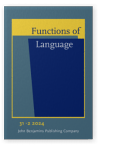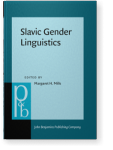Laura A. Janda
List of John Benjamins publications for which Laura A. Janda plays a role.
Journal
Titles
Corpus Approaches to Language, Thought and Communication
Edited by Wei-lun Lu, Naděžda Kudrnáčová and Laura A. Janda
[Benjamins Current Topics, 119] 2021. v, 157 pp.
Subjects Cognition and language | Cognitive linguistics | Corpus linguistics | Theoretical linguistics
Corpus Approaches to Language, Thought and Communication
Edited by Wei-lun Lu, Naděžda Kudrnáčová and Laura A. Janda
Special issue of Review of Cognitive Linguistics 17:1 (2019) vi, 301 pp.
Subjects Cognition and language | Cognitive linguistics
2023 From data to theory: An emergent semantic classification based on the large-scale Russian constructicon Constructions and Frames 15:1, pp. 1–58 | Article
The semantic classification of over 2,200 constructions in the Russian Constructicon has emerged objectively from empirical analysis. The resulting semantic classification comports with and goes beyond frame semantics, revealing complex patterns of related constructions verified against corpus… read more
2022 Chapter 6. From nouns to verbs: Analogy across parts of speech Analogy and Contrast in Language: Perspectives from Cognitive Linguistics, Krawczak, Karolina, Barbara Lewandowska-Tomaszczyk and Marcin Grygiel (eds.), pp. 159–192 | Chapter
A conceptual metaphor motivates an analogy between nouns and verbs, here termed the Noun → Verb Analogy. The metaphor maps properties from the source domain of space for nouns to the target domain of time for verbs. Three case studies present evidence for this metaphorical analogy using data… read more
2021 Quantitative perspectives in Cognitive Linguistics Corpus Approaches to Language, Thought and Communication, Lu, Wei-lun, Naděžda Kudrnáčová and Laura A. Janda (eds.), pp. 7–28 | Chapter
As a usage-based approach to the study of language, cognitive linguistics is theoretically well poised to apply quantitative methods to the analysis of corpus and experimental data. In this article, I review the historical circumstances that led to the quantitative turn in cognitive linguistics… read more
2021 Deep dives into big data: Best practices for synthesis of quantitative and qualitative analysis in Cognitive Linguistics Corpus Approaches to Language, Thought and Communication, Lu, Wei-lun, Naděžda Kudrnáčová and Laura A. Janda (eds.), pp. 1–6 | Chapter
2020 How to build a constructicon in five years: The Russian example The Wealth and Breadth of Construction-Based Research, Colleman, Timothy, Frank Brisard, Astrid De Wit, Renata Enghels, Nikos Koutsoukos, Tanja Mortelmans and María Sol Sansiñena (eds.), pp. 161–173 | Article
We provide a practical step-by-step methodology of how to build a full-scale constructicon resource for a natural language, sharing our experience from the nearly completed project of the Russian Constructicon, an open-access searchable database of over 2,200 Russian constructions (https://site. read more
2019 Quantitative perspectives in Cognitive Linguistics Corpus Approaches to Language, Thought and Communication, Lu, Wei-lun, Naděžda Kudrnáčová and Laura A. Janda (eds.), pp. 7–28 | Article
As a usage-based approach to the study language, cognitive linguistics is theoretically well poised to apply quantitative methods to the analysis of corpus and experimental data. In this article, I review the historical circumstances that led to the quantitative turn in cognitive linguistics and… read more
2019 Name-calling: The Russian ‘new Vocative’ and its status Perspectives on Language Structure and Language Change: Studies in honor of Henning Andersen, Heltoft, Lars, Iván Igartua, Brian D. Joseph, Kirsten Jeppesen Kragh and Lene Schøsler (eds.), pp. 381–394 | Chapter
Henning Andersen (2012) points out that the Russian “new Vocative” (e.g., мам! ‘mama!’, Саш! ‘Sasha!’) presents a series of unusual behaviors that set it apart from ordinary case marking. Andersen argues that the Vocative should not be considered a declensional word form of nouns. The Russian… read more
2019 Deep dives into big data: Best practices for synthesis of quantitative and qualitative analysis in Cognitive Linguistics Corpus Approaches to Language, Thought and Communication, Lu, Wei-lun, Naděžda Kudrnáčová and Laura A. Janda (eds.), pp. 1–6 | Article
2018 Chapter 6. A constructicon for Russian: Filling in the gaps Constructicography: Constructicon development across languages, Lyngfelt, Benjamin, Lars Borin, Kyoko Ohara and Tiago Timponi Torrent (eds.), pp. 165–181 | Chapter
The Russian Constructicon project currently prioritizes multi-word constructions that are not represented in dictionaries and that are especially useful for learners of Russian. The immediate goal is to identify constructions and determine the semantic constraints on their slots. The Russian… read more
2016 The ongoing eclipse of possessive suffixes in North Saami: A case study in reduction of morphological complexity Diachronica 33:3, pp. 330–366 | Article
North Saami is replacing the use of possessive suffixes on nouns with a morphologically simpler analytic construction. Our data (>2K examples culled from >.5M words) track this change through three generations, covering parameters of semantics, syntax and geography. Intense contact pressure on… read more
2015 The role of non-canonical subjects in the overall grammar of a language: A case study of Russian Subjects in Constructions – Canonical and Non-Canonical, Helasvuo, Marja-Liisa and Tuomas Huumo (eds.), pp. 293–317 | Article
We offer a model of Russian core syntax in terms of a radial category network
of constructions. The prototype corresponds to Langacker’s “canonical event
model”, namely a prototypical transitive event, and more peripheral constructions
are related to it via metaphor and metonymy. From this… read more
2010 Chapter 5. Perfectives from indeterminate motion verbs in Russian New Approaches to Slavic Verbs of Motion, Hasko, Victoria and Renee Perelmutter (eds.), pp. 125–139 | Article
Motion verbs are “exceptions” to the Russian aspect system because: (1) they have two stems (determinate and indeterminate); and (2) prefixation of indeterminate stems yields imperfective verbs (cf., uxodit’i ‘leave’). Furthermore, as an exception to (2), there are some prefixed perfective verbs… read more
2007 Aspectual clusters of Russian verbs Studies in Language 31:3, pp. 607–648 | Article
The traditional “pair” model of Russian aspect fails to distinguish among Perfectives and ignores the fact that most verbs exist in larger clusters of three or more aspectually related forms. I propose semantic parameters that account for the interaction of aspect and actionality and use them to… read more
2000 From Number to Gender, from Dual to Virile: Bridging Cognitive Categories Between Grammar and Lexicon, Contini-Morava, Ellen and Yishai Tobin (eds.), pp. 73–86 | Article
1999 Whence virility? The rise of a new gender distinction in the history of Slavic Slavic Gender Linguistics, Mills, Margaret H. (ed.), pp. 201–228 | Article
1999 Implementation of the FIGURE-GROUND Distinction in Polish Lexical and Syntactical Constructions and the Construction of Meaning: Proceedings of the bi-annual ICLA meeting in Albuquerque, July 1995, Verspoor, Marjolijn H., Kee Dong Lee and Eve Sweetser (eds.), pp. 149–164 | Article
1998 GIVE, HATE, and TAKE in Slavic The Linguistics of Giving, Newman, John (ed.), pp. 249–266 | Article
1988 The mapping of elements of cognitive space onto grammatical relations: An example from Russian verbal prefixation Topics in Cognitive Linguistics, Rudzka-Ostyn, Brygida (ed.), pp. 327–344 | Article
The semantic change of faqare (‘vertebra’, ‘unit’) as a numeral classifier in Persian Review of Cognitive Linguistics: Online-First Articles | Article
This article deals with an ongoing semantic change in which Persian faqare (‘vertebra’, or ‘unit’) is transitioning from a specific numeral classifier to a general numeral classifier in the grammatical construction Num + faqare + NP. In this transition the connections to the prototypical… read more
The lexicon-grammar continuum: What Persian complex predicates reveal Constructions and Frames: Online-First Articles | Article
We argue for the lexicon-grammar continuum by looking into the separability of Persian complex predicates, an open class of verb constructions for which it has been argued that the components are either separable or inseparable. We contend that separability is best described as a scalar rather… read more
















